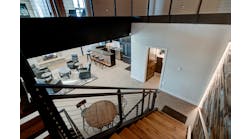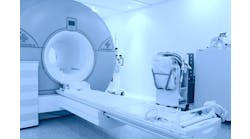Screaming fans will pack the new San Francisco 49ers Levi’s Stadium for the 2016 Super Bowl. In the meantime, the 49ers are breaking in the new $1.3 billion, 1.85-million-sq-ft stadium in Santa Clara, Calif.
Completed in July 2014, the new stadium was built nearly 50 miles away from the existing Candlestick Park stadium, which is scheduled to be flattened in 2015. The new facility is located adjacent to the 49ers headquarters building and practice fields.
Dubbed the “most technologically advanced stadium in the world,” the new facility features 1,250 wireless access points, making it one of the most covered stadiums in the United States, says Jim Medefesser, project executive for Cupertino Electric, which worked for a Turner and Devcon Construction joint venture on the project.
Cupertino Electric installed the power, fiber backbone, and structured cabling for on-site Internet Protocol televisions (IPTVs), wireless access points, and the directional antennae system (DAS). With 600 antennas and 400 amplifiers to boost coverage for all major telecommunications carriers, the site boasts the largest stadium-based distributed antenna systems.
“There is coverage everywhere,” Medefesser says. “The antennas are located under the seats and in the concourses, tunnels, overhangs, and tower.”
As a result, patrons can watch high-definition replays from multiple camera angles in either slow or regular motion on their mobile devices only seconds after a play. They can also live tweet in the stadium, buy or exchange tickets or parking passes, and find the nearest concession stand or bathroom. Also, from any seat in the stadium, fans can order food, drinks, or merchandise, which is then hand-delivered by stadium staff. This takes in-person sports viewing to an entirely new level.
Aside from the patron experience, the addition of technology to assist the coaches and broadcast personnel during the game has also been enhanced.
“Most people might not realize, but each player on the field has a GPS tracking device embedded in his uniform to track movement, execution of plays, and distance traveled during a game for statistical purposes,” says Dave Dorcak, Cupertino Electric’s low-voltage project manager. Dorcak worked closely with NFL vendors to design and install the required tracking system.
“A full separate system was installed throughout the bowl with antennas and location devices to accurately track each player to within plus or minus a foot,” he says.
Working on the fast track
In addition to its technological capabilities, Levi’s Stadium also stands apart from other professional football stadiums as far as the speed of construction. Cupertino wrapped up the electrical design two months ahead of schedule and within the construction budget.
“One of the biggest challenges of the project was that everything moved very fast with many scope additions,” Medefesser says. “It was one of the quickest stadiums ever built.”
Cupertino designed and built the entire electrical infrastructure for the stadium. The union contractor installed the 12kV primary power, 480V distribution, and fire alarm systems, as well as the high-end club lighting and sports field lighting systems. Furthermore, the company’s electricians installed the emergency power system equipment and raceway for all low-voltage systems. The company’s workforce peaked at 270 electricians and 60 low-voltage technicians to keep pace with the high volume of work.
Cupertino’s in-house engineering and BIM teams began working on the lectrical design in February 2012. Two months later, the underground work at the stadium commenced. Then, in late July, the steel erection phase of the project got underway. By July 2014, the San Francisco 49ers celebrated the grand opening of the stadium (see Fast Facts).
Since that time, however, Cupertino has handled a large influx of scope additions. Specifically, the company was asked to add more receptacles, make changes in X-ray rooms, and build-out spaces not originally planned for.
“We continued to work past the completion date, and the changes haven’t stopped,” Medefesser says. “When [the stadium] sold sponsorships and naming rights, we handled the power and the lighting for areas that were considered for future use. What made it difficult was that we were no longer in the raw construction stage. As a result, we had to go back into finished areas and work, which was very challenging.”
Coordinating changes
Despite the significant scope additions, Cupertino was able to finish the majority of its electrical and structured cabling work in time for the first sports event at the new stadium. The first inaugural event was a San Jose Earthquakes soccer game held on Aug. 2, 2014.
One key to keeping the project on schedule was assigning four full-time employees to input electrical drawings in a building information modeling (BIM) system.
“With that many people in the field and the number of changes being made, it can be extremely difficult to keep track of them with pencil and paper,” Medefesser says. “If there were any changes, then our foremen and general foremen were notified instantly, and they could access the latest drawings instantly on their iPads.”
The 3D model included the electrical, architectural, mechanical, and fire alarm system drawings, which helped significantly with clash detection and coordination. For example, BIM made it easier for the workers to construct the service tunnel, which contained major infrastructure components such as chilled water lines, duct work, waste water, conduit and cable trays for fiber backbone, security, A/V, and broadcast and structured cable.
“By working in BIM, the job went much more smoothly because it minimized rework,” Medefesser says. “We could get the routing of the conduits approved before the electricians began their work in the field.”
Going green
The company also helped install a renewable energy system at the stadium. Working for NRG Energy and Sunora Energy Solutions, the contractor’s solar team installed about 1,180 solar panels on site, which produce nearly 400kW of power. Half of the panels are located on the roof; the other half are located on pedestrian bridges that span the creek and connect the parking lot to the stadium.
“The power generated from the solar panels can supply enough power for all the home games throughout the season,” Medefesser says. “Because the stadium owners are only using the facility at certain times, they can also monitor and shut off power and lighting as needed on non-event days.”
In addition to the photovoltaic system, Cupertino Electric also installed energy-efficient lighting components and systems. Case in point: About 80% of the luminaires feature LED technology, which also offers the benefit of instant on-off capability for emergency situations when compared to HID fixtures. Also, through a central lighting control system with graphical display, stadium operations staff can easily and conveniently illuminate only certain areas of the stadium for special events.
“People normally think of a football stadium as the field and the stadium seating, but this facility offers so much more,” Medefesser says. “While we worked hard and were tired at the end of the job, we are definitely looking forward to the Super Bowl.”
SIDEBAR: FAST FACTS
- 174.1kW rooftop solar system located on the green roof area
- 209.7kW solar system installed on pedestrian bridges
- 2,400 Internet Protocol televisions (IPTVs)
- 400,000 sq ft of indoor/outdoor meeting space
- More than 2.5 million linear feet of Cat. 6A cable
- 450 miles of conduit
- 1,700 miles of conductor
- 16,000 luminaires
- 13,000 circuit breakers
- 1,250 wireless access points and 600 DAS antennas
- Full server room/data center on site with 52 telecom rooms
- Main service consists of two 12kV feeders, rated at 12MW each. Both are distributed within the stadium with an automatic transfer scheme in the event of an electric utility failure. Each circuit can handle the facility’s load on its own.
- Four 3,333kVA double-ended substations with eight 4,000A 480V switchboards, two 500kVA scoreboard substations, one 750kVA substation for DAS and communications, one 1,330kVA substation with a 4,000A 208V switchboard for show power and the broadcast trucks, and one 200kVA substation for the fire pump system.
Editor’s Note: Visit bit.ly/1yi4Koj to see the construction camera perspective.
Amy Fischbach is a freelance writer based in Overland Park, Kansas. She can be reached at [email protected].


